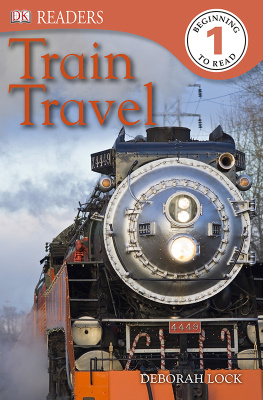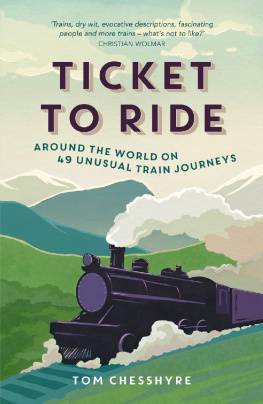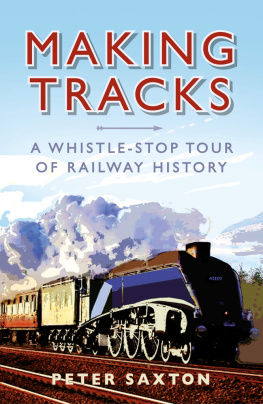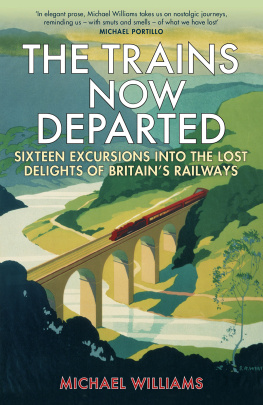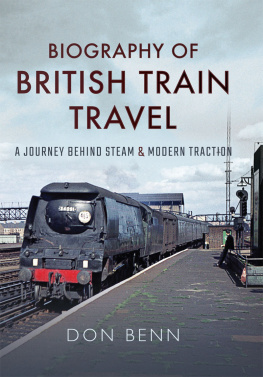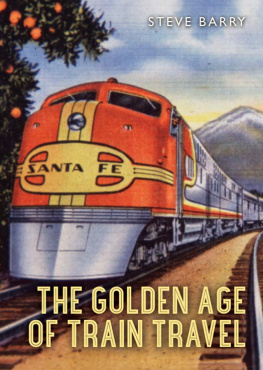Train Tracks
Train Tracks
Work, Play and Politics on the Railways
GayleLetherbyandGillianReynolds
First published 2005 by Berg publishers
Published 2020 by Routledge
2 Park Square, Milton Park, Abingdon, Oxon OX14 4RN
605 Third Avenue, New York, NY 10017
Routledge is an imprint of the Taylor & Francis Group, an informa business
Copyright Gayle Letherby and Gillian Reynolds 2005
All rights reserved. No part of this book may be reprinted or reproduced or utilised in any form or by any electronic, mechanical, or other means, now known or hereafter invented, including photocopying and recording, or in any information storage or retrieval system, without permission in writing from the publishers.
Notice:
Product or corporate names may be trademarks or registered trademarks, and are used only for identification and explanation without intent to infringe.
Library of Congress Cataloguing-in-Publication Data
Letherby, Gayle.
Train tracks: work, play and politics on the railways/Gayle Letherby
and Gillian Reynolds.
p. cm.
Includes bibliographical references and index.
ISBN 1-84520-083-7 (pbk.)ISBN 1-84520-082-9 (cloth)
1. RailroadsSocial aspects. 2. Railroad travelSocial aspects.
I. Reynolds, Gillian. II. Title.
HE1031.L48 2005
306.3dc22 2005005532
British Library Cataloguing-in-Publication Data
A catalogue record for this book is available from the British Library.
ISBN13: 978-1-8452-0082-4 (hbk)
ISBN 13: 978-1-8452-0083-1 (pbk)
Typeset by Avocet Typeset, Chilton, Aylesbury, Bucks
As a joint endeavour this book has been a joy to write. We have been able to indulge our interest in trains and train travel and our friendship. However, as with all research and writing projects, there is a need to acknowledge the help and contributions of others. We are grateful, of course, to the many people who took part in our research as respondents: as well as providing us with essential data they - and others - encouraged us with their ongoing enthusiasm for our project. The finished product is our own responsibility.
We would like to thank Paul Bywaters and other members of the Centre for Social Justice, Coventry University, and Tim Strangleman (London Metropolitan University) for support, encouragement and critical insight; David Bill (Billy) for the cover picture and line drawings; Dave McAlone, John Hunt, Robert Hart, Mike Jager and Henry Lewis for permission to use artwork; 'Jon', whom Gillian met at York station, for permission to take a photograph for use in this book; and the anonymous traveller who kindly agreed to photograph us at work on the train. We are also grateful to Clive Reynolds for valuable technical support, and to Kathryn Earle and Hannah Shakespeare for using carrots rather than sticks during the production of our manuscript.
The Train Now Standing ...
Oh, you're writing a book about trains and tram travel, how great. And if you are late finishing it you can write in the introduction - 'We are sorry for the delay and for any inconvenience to your reading' [laughter].
Janet - UK
In this book we consider work, play and politics on the train and as such explore social and cultural aspects of the train and train travel. As two sociologists, our aim in this book is to begin to make visible an area of everyday life largely ignored by social scientists. Although transport is an area that has been explored, this has more often been in the process of examining exclusion, poverty, inner city life or urban planning. As Edward de Boer (1986) notes, '(t)here is hardly a tradition of studying the social aspect of transport'. This is a serious omission as the train and train travel hold an important place in many people's lives. As a cultural icon and/or a focus of leisure pursuits, as a formal or constructed place of work and in terms of personal and public politics, the train holds significance.
Drawing on social and cultural theory, secondary analysis of cultural artefacts (including 'on-board' magazines, TV programmes, literature and films, and historical documents) and the analysis of primary data (collected via single and focus group interviews and email) from worldwide train travellers, workers and enthusiasts, we consider in this book the practical and political significance of the train both historically and to date. As two British scholars with easier access to the politics and experience of the British railways, we are largely concerned here with an exploration of the experience of trains and train travel in Britain. At times, however, we make comparisons with trains and train travel in other cultures, not least because some of our respondents comment on their worldwide relationship with trains.
We are not suggesting that our analysis is completely unique. Stephen Page (1999) briefly explores aspects of British train travel in the context of tourism and Chris Rojek and John Urry (1997) also address the part which travelling plays in tourism. In both these publications, however, the social phenomenon of what actually goes on during a journey and also the fascination in which trains are held as a cultural icon and social symbol are generally overlooked. Some writers have examined the place of trains in cultural nostalgia whilst others explore the railway industry from economic and historical perspectives (e.g. White 1995; Divall 2003; Marchant 2003; Strangleman 2004). While all these writers address briefly some areas of interest to us, none have brought together, as we do, the combined consideration of:
- travellers' experiences of being on a train (as distinct from experiences of service provision);
- railway workers' experiences of working on the train and for the railway industry;
- perceptions of trains and train travel among rail enthusiasts;
which we believe enables the concept of the train to be analysed as a cultural and social phenomenon in its own right.
In the introduction to his book Parallel Lines, or Journeys on the Railway of dreams, Ian Marchant (2003:13) notes that: 'The first chapter, or introduction, of any self-respecting railway book is always called something along the lines of "Departures" or "The Train now Standing" ... The last chapter is always, always always called "All Change" and is invariably about Beeching. Fans of the genre will find this aspect of my book ... reassuringly familiar.' Although we have not completely conformed to stereotype, you will see that we too have attempted humorous titles for our chapters:
- Introduction The Train Now Standing
- Points and Branch Lines
- Leaves on the Line
- Signs and Signals
- All Aboard the 'Play Station'
- Working on the Line
- Standing Room Only
- Reflections Light at the End of the Tunnel?
Our personal interest and affection for trains and train travel are shared by many of the authors that we cite throughout this book and by the majority of our respondents (as highlighted by the quote with which we began). However, this affection is not merely the preserve of those represented here - as authors and/or respondents - because the train holds a place in many people's hearts. But, as Janet's account suggests, this affection is often tinged with frustration, and humour is just one of the ways in which this frustration is manifested. This tension between affection and frustration is present throughout this book.


